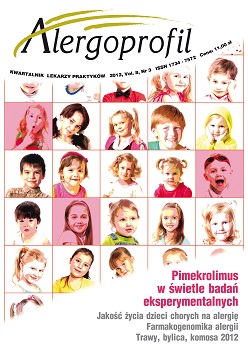Nutritional status and dietary intake in children with cow’s milk allergy
Main Article Content
Abstract
Introduction: Poor different acceptance of milk-free formulas in the diet of children with allergy to cows’ milk (CMA) poses the risk of nutritional deficiencies especially calcium, vitamin D and iron and also can lead to malnutrition.
Purpose: The objective of this study was to assess the nutritional status and diets of children diagnosed with cows’ milk allergy (CMA) and healthy age-matched controls.
Material and methods: Sixty children aged 2–5 years referred to the Institute of Mother and Child because of suspected cow’s milk allergy were enrolled in the study. Children were divided into two groups: group I – 40 children with CMA, group II – 20 healthy controls. In children diagnosed with allergy to cow’s milk, milk free diet was recommended. Dietary intake and nutritional status were assessed at six-monthly intervals: at the beginning of the study and after 6 and 12 months of observation. All children’s diets were evaluated by means of 7-day records. Nutritional status of children was assessed with anthropometric traits and indices (i.e. BMI) and selected biochemical parameters were performed.
Results: At the beginning of the study the mean intake of protein, fat and some vitamins B and sodium intake was significantly lower in children from the group I than in children from the group II. After 6 months, higher intakes of energy, fat and sodium and lower vitamin D and vitamin C were found in the group II. The average daily intake of nutrients assessed after 12 months did not show significant differences in children from both groups. Children from both group did not meet the recommended calcium and folate intake. Children of the group II throughout the observation intakes lower iron while the children in group I only at the beginning of the study. The supply of vitamin D was only deficient in the diets of children in group II. Despite differences in the average concentration in the serum of children with both groups of proteins, albumin and iron, their values ranged of standards for age, as well as the assessed value of other biochemical parameters. At the beginning of the study BMI z-score of 75% of children in group I and 80% in group II ranged between -1,0 to +1,0 whereas BMI z-score in 25% of group I and 20% of group II between -2,0 and -1,0. After 12 month follow-up in 91,5% of children of group I and 88% of group II BMI z-score was between -1,0 to +1,0 while in 8,5% of children in group I and 12% in group II between -2,0 to -1,0.
Conclusions: Nutritional status of children with CMA assessed by body mass index, and selected biochemical tests was normal. In children during 12 month of period of the study, positive changes in dietary habits were observed. Children with CMA should remain under pediatric and dietician care in order to monitor their nutritional status and diet. Nutrition care is also indicated for children on a traditional diet.
Downloads
Article Details
Copyright: © Medical Education sp. z o.o. This is an Open Access article distributed under the terms of the Attribution-NonCommercial 4.0 International (CC BY-NC 4.0). License (https://creativecommons.org/licenses/by-nc/4.0/), allowing third parties to copy and redistribute the material in any medium or format and to remix, transform, and build upon the material, provided the original work is properly cited and states its license.
Address reprint requests to: Medical Education, Marcin Kuźma (marcin.kuzma@mededu.pl)
References
2. Charzewska J., Chlebna-Sokół D., Chybicka A. et al.: Polskie zalecenia dotyczące profilaktyki niedoborów witaminy D – rok 2009. Standardy Medyczne/Pediatria 2009, 6: 1-4.
3. Buczek S., Kamer B., Pasowska R. et al.: Ocena sposobu żywienia niemowląt i małych dzieci z alergią pokarmową. Pediatria Współczesna. Gastroenterologia, Hepatologia i Żywienie Dziecka 2006, 8: 175-179.
4. Paganus A., Juntunen-Backman K., Savilahti E.: Follow-up nutritional status and dietary survey in children with cow’s milk allergy. Acta Paediatrica 1992, 81: 518-521.
5. Charzewska J., Weker H.: Ogólnopolskie badanie nad zawartością wapnia i witaminy D w dietach dzieci w wieku 4 lat. Pediatr. Współcz. Gastroenterol. Hepatol. Żywienie Dziecka 2006, 8: 107-109.
6. Kurpińska P., Weker H., Rowicka G. et al.: Ocena postępowania żywieniowego u dzieci z alergią pokarmową na białka mleka krowiego. Postępy Żywienia Klinicznego 2010, 1: 12-16.
7. Salman S., Christie L., Burks W. et al.: Dietary intakes of children with food allergies: comparison of the Food Guide Pyramid and the Recommended Dietary Allowances, 10th ed. Journal of Allergy and Clinical Immunology 2002, 109: 21.
8. Recommended Dietary Allowances: 10th Edition. Subcommittee on the Tenth Edition of the RDAs Food and Nutrition Board Commission on Life Sciences National Research Council National Academy Press, Washington, D.C., 1989.
9. Nordic Nutrition Recommendation for one-to two-year old children. Nordisk Ministerrad. Nordiska Naringsrekommendationer. Andra upplagan, Rapport 1989: 2.
10. Mowszet K., Piasecka A., Reich M. et al.: Przyczyny niedożywienia u dzieci do lat pięciu w materiale własnym. Adv. Clin. Exp. Med. 2005, 14: 315-322.
11. Gębala A., Czaja-Bulsa G., Korlatowicz-Bilar A. et al.: Ocena stanu odżywienia u dzieci hospitalizowanych z różnych przyczyn pediatrycznych. Pediatr. Współcz. Gastroenterol. Hepatol. Żywienie Dziecka 2008, 10: 133

